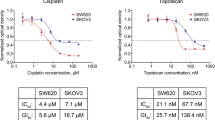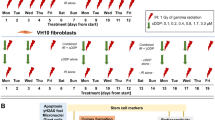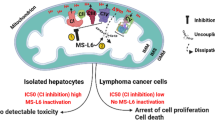Abstract
Lonidamine or 1-[(2, 4-dichlorophenyl) methyl]-1H-indazole-3-carboxylic acid, studied in a battery of in vitro and in vivo tests currently used for the screening of anti-tumour agents affecting cell division, has been shown to have a narrow spectrum of anti-tumour activity. The significance of this finding is discussed in the light of previous investigations suggesting that lonidamine affects mitochondrial function and not cell replication. Hyperthermia has been shown to sensitize tumour cells to lonidamine. This observation indicates that in combination with hyperthermia lonidamine has some potential for the treatment of cancer, moreover, it suggests that hyperthermia might reproduce a metabolic condition occurring in some stages of the disease. The blood levels corresponding to the anti-tumour action of lonidamine in animals are in the range of those detected in patients treated with the drug.
This is a preview of subscription content, access via your institution
Access options
Subscribe to this journal
Receive 24 print issues and online access
$259.00 per year
only $10.79 per issue
Buy this article
- Purchase on Springer Link
- Instant access to full article PDF
Prices may be subject to local taxes which are calculated during checkout
Similar content being viewed by others
Rights and permissions
About this article
Cite this article
Silvestrini, B., Hahn, G., Cioli, V. et al. Effects of lonidamine alone or combined with hyperthermia in some experimental cell and tumour systems. Br J Cancer 47, 221–231 (1983). https://doi.org/10.1038/bjc.1983.30
Issue Date:
DOI: https://doi.org/10.1038/bjc.1983.30
This article is cited by
-
Effect of Differences in Metabolic Activity of Melanoma Models on Response to Lonidamine plus Doxorubicin
Scientific Reports (2018)
-
Relative cytotoxicities of Adriamycin and epirubicin in combination with lonidamine against human bladder cancer cell lines
Urological Research (1995)
-
In vitro potentiation by lonidamine of the cytotoxic effect of adriamycin on primary and established breast cancer cell lines
Breast Cancer Research and Treatment (1992)
-
Kinetic and survival response of the M14 cell line to lonidamine associated with adriamycin or hyperthermia
Journal of Cancer Research and Clinical Oncology (1987)



